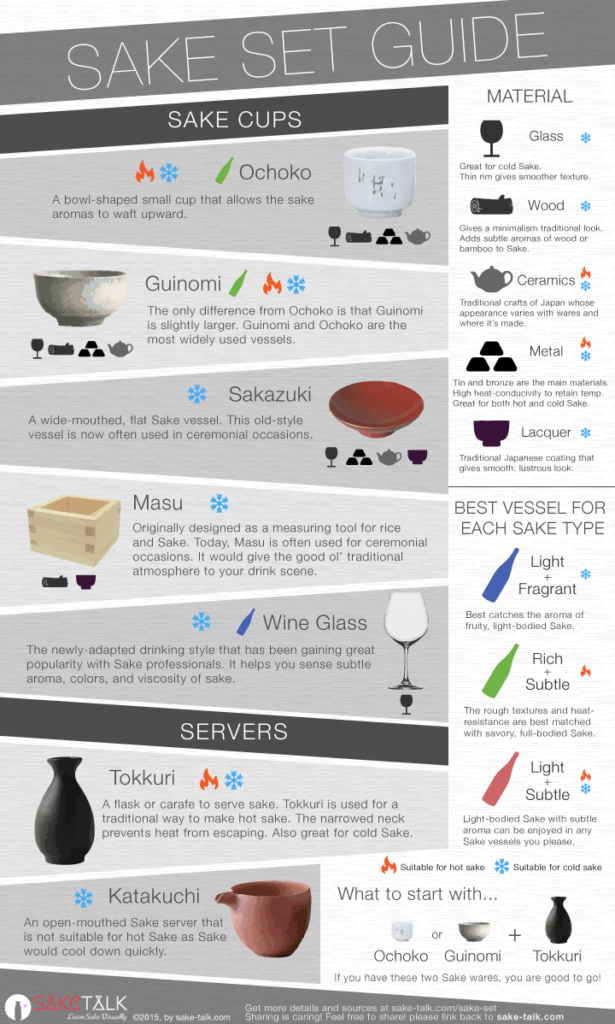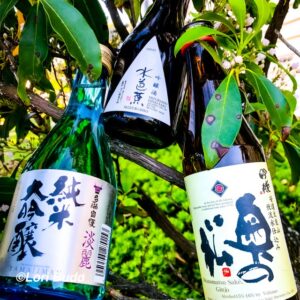I have never had sake in my life. I am not really sure why, but I just never have. I love going to hibachi houses where it is often served, but I always stuck with the familiar beers on the list. It wasn’t even mentioned in my WSET training and in all honesty, I didn’t even know how sake was made, other than that it used rice rather than grapes. But, as I learned, there is so much more to it than “rice wine.”
Terminology
When you know nothing about a subject, there is so much to learn! First off, you may see the term spelled sake or saké. I will say it is a lot easier to find information using the later, since without the acute (é) Google automatically assumes you are using the term meaning for the purpose of; in the interest of; in order to achieve or preserve. The proper way to pronounce it is “sa-kay” and there should be no acute. Also known as nihonshu (literally translates to, “Japanese liquor”) in Japan it is the national beverage. You will often see it served during special events such as weddings.
When drinking sake or I should say seeing someone drinking sake, most people often see it poured from a tall bottle and sipped from a small porcelain or earthenware cup. There are a multitude of sets available, depending on the situation it is being drunk in. The sets themselves range from traditional to modern as well as being minute or very elaborate.
The tall bottle has two basic forms called a tokkuri or a katakuchi. The tokkuri is the traditional pouring vessel. It is basically a carafe with a narrow neck to keep the warmth of the sake in. The katakuchi is shorter and has an open mouth. It is like a large saucer and is more often used with cool sake.
The sakazuki is the oldest style of cup and in its wide-mouthed form is the most popular for ceremonies for its dramatic effect. The proper way to drink is to raise the cup to your mouth with both hands. One on the bottom and one on the side.
The guinomi cup was most popular during the Edo Period (1603-1868.) This cup is larger than a sakazuki so is typically enjoyed in a more casual setting rather than a formal event. Another type of cup is the ochoko is very similar to a guinomi, but in the strictest sense, ochoko are generally smaller than guinomi and instead of being in a cup shape are more like a thimble shape. There is a special ochoko cup, called janome choko or kikichocko which has a concentrated blue and white pattern. This pattern is said to help in the evaluation of the sake’s color, clearness and fragrance.
The final type of traditional drinking cup is the masu. This cup also dates back to the Edo Period and is a square box. Although it became a drinking vessel, its origin was for measurement, not drinking. Merchants would use the masu to measure rice, other grains, soy sauce, vinegar and sake. It became the cup of choice at festivals thanks to its difficulty to break and ability to hold a large amounts. High quality masu cups are made from Japanese cypress “hinoki” (Chamaecyparis obtusa).
If you are willing to break away from tradition, many people are now recommending drinking sake from a wine glass. A white wine glass, allows the consumer to enjoy the aromas, while an old fashioned tumbler is ideal for sake that is recommended to be served over ice. (more on that later)

History
Although not exactly known, the first mention of consumption of sake in China dates back to around 500 BC. If you think that crushing grapes with bare feet is not the most hygienic, you may want to skip the rest of this paragraph. In it’s earliest form, members of the communities would come together to chew rice and nuts. They would then spit the contents into a communal tub where it would be stored. Thanks to the enzymes in their saliva, fermentation could occur. Once the mold enzyme, koji, was discovered to have the ability to aid in fermentation, the spitting brewing technique was abandoned. It is believed that this occurred during the Nara period (710 to 794), and has resulted in the sake that is popular today.
Originally, sake was produced solely by the governmental agency. However, during the 10th century, temples and shrines began brewing their own. With sake being produced through these avenues, by the 1300s, it became the national drink for ceremonies in Japan. Sake production got a little out of hand during the Meiji Restoration (1868 to 1912.) New laws that were put into effect allowed anyone with who could brew sake to open their own brewery. Within a year, over 30,000 new breweries opened in Japan. That was quickly remedied by instilling taxes on sake producers, which effectively forced over two-thirds to shut down.
Today, there are less than 2000 sake brewers in Japan, but more and more breweries are opening in North and South America, China, Southeast Asia, and Australia. And as with everything else, there of course is a Sake Day! Originated in Japan, it was celebrated annually on October 1st, but is now celebrated across the globe.
Categories of Sake
The first thing, of many that I didn’t know, was that sake can be served warm or cold (I always thought it was a warm beverage) and according to Sake World, sake comes in four basic types. Each is based on its different brewing method.
- Junmai-shu (rice only; no adding of distilled alcohol)
Fragrance none —-X———————- fragrant Impact quiet ——————X——– explosive Sweet/Dry sweet ————-X————- dry Acidity soft ———————-X—- puckering Presence unassuming ———————-X—- full Complexity straightforward —-X———————- complex Earthiness delicate ————-X————- dank Tail brief ——————X——– pervasive - Honjozo-shu (a tad of distilled alcohol is added)
Fragrance none ——————–X—— fragrant Impact quiet —–X——————— explosive Sweet/Dry sweet —–X——————— dry Acidity soft —-X———————- puckering Presence unassuming —-X———————- full Complexity straightforward ———————X—– complex Earthiness delicate ———————-X—- dank Tail brief ———————-X—- pervasive - Ginjo-shu (highly milled rice, with or without alcohol added)
Fragrance none ———————–X— fragrant Impact quiet ——-X——————- explosive Sweet/Dry sweet ——-X——————- dry Acidity soft ——X——————– puckering Presence unassuming ——X——————– full Complexity straightforward ———————–X— complex Earthiness delicate –X———————— dank Tail brief ——X——————– pervasive - Daiginjo-shu (even more highly milled rice, with/without added alcohol)
Fragrance none ————————–X fragrant Impact quiet ———-X—————- explosive Sweet/Dry sweet ———-X—————- dry Acidity soft ——–X—————— puckering Presence unassuming ———————–X— full Complexity straightforward ————————–X complex Earthiness delicate ———-X—————- dank Tail brief -X————————- pervasive - Nama-zake (refers to sake that is NOT pasteurized) and basically is mutually independent of the above four
Let’s Get Sipping!
Sake may not always be the easiest to come by. Although Japanese sake makers would obviously love to expand their business in the U.S it is all based on demand. Since it is only slowly being created here, it is difficult for the importers to justify wider distribution. Enter Tippsy Sake. They cut out the middlemen to keep the supply chain simple and offer a large selection of sake
At Tippsy, our mission is to make sake simple and fun. By designing the platform for you to easily find your favorite brand and streamlining logistics so you can drink the freshest sake shipped from the West Coast where most sake arrives from Japan, we want you to re-evaluate your experience with sake and re-discover the flavors that you thought you knew.
Their website makes learning, and shopping, for sake easy. You can search through their inventory by taste, price, brand or category. Think of them as your online subscription for DTC sake. You can choose to subscribe to a monthly plan or purchase individual boxes. Each box contains 3 x 10 oz mini bottles. Each bottle in the subscription box ranges between $20–40 at restaurants and they are shipped free.
The subscription is extremely flexible, allowing you to choose when and how often you would like to receive you box and each sake comes with an information card, so you know what you are drinking. Their website is extremely easy to navigate and is transparent in what you will be receiving in the subscription boxes. What I really liked, was the graphics provided when I was searching for a bottle. They provide easy to understand (for us sake newbies) information about characteristics, serving temperature, tasting notes, recommended pairings and the region the sake is coming from, as well as information about the brewery itself.
All three of my bottles were recommended to be served cold, so that is exactly what I did. Having never had sake before, I do not own a sake set, so a white wine glass it was. Before, pouring the the first wine into my glass, I looked at the information cards provided and realized, WOW! these babies have some punch. The lowest ABV was 14.5%, with the other two rang in at 15% and 16%. The other notable measurement on the cards was the RPR (rice polishing ratio). The rice polishing ratio is the percentage of the rice that remains after the husk (outer portion) is polished off. These portions contain more protein and fats than the inner portion of the grain and can produce undesirable aromas and negative flavors in the sake.
Tamajiman “Junmai Daiginjo” (SRP: ?)
“Daiginjo” requires a rice polishing ratio of 50% or less. They are made in smaller quantities, and rely more on traditional methods. Brewers use their highest skills and knowledge to extract the full flavor and aroma from the rice and craft the best quality sake possible. Daiginjo showcases the level of craftsmanship of brewers as it takes a lot of effort and delicate care to achieve the perfect balance of flavors.
Pours pale, clear, straw in color. On the nose, clean, pronounced aromas of white flower, almond paste, citrus zest, cedar and juniper. On the palate, dry, low acid, light body, medium alcohol, medium flavors of almond paste and cashew with a medium (-) finish. 14.5% ABV, 50% RPR Brewed using underground mineral water from the Tama River.
Okunomatsu “Ginjo” (SRP: $28.50)
”Ginjo” is brewed with rice grains that are polished down to 60% or less. By brewing at lower temperatures the well-polished rice can bring out the aroma components which are also found in fruits like bananas and apples.
Pours pale, clear, straw in color. On the nose, clean, medium aromas of black licorice, cashew and apple sauce. On the palate, dry, low acid, light body, medium (-) alcohol, medium flavors of melon, and nectarine, banana and coconut with a medium (-) finish. 15% ABV, 60% RPR Brewed as a prime example of ginjo style sake.
Mizubasho “Ginjo” (SRP: $33)
Pours pale, clear, light lemon-straw in color. On the nose, clean, medium aromas of floral, wet stone kiwi and steamed vegetables. On the palate, dry, low acid, light body, light alcohol, medium (-) flavors of salinity, stone, kiwi and melon with a short but really pleasant finish. 16% ABV, 50% RPR Brewed from snow melt and rainwater that was filtered then pumped in the village of Kawaba.

~For this post, I thought it would be more appropriate to end with Kanpai! (sounds like “gahn-pie”) instead of my traditional Sláinte!
Please follow me on Instagram, Twitter, and Facebook. You can also find me on YouTube and if you are interested in wine pairings, follow my other blog, Wine Pairing with Dracaena Wines. And don’t forget about my FREE wine education series, Winephabet Street. Sláinte!
Please Visit our Sponsors:




Fun, informative article Lori! Although I love sake and visited one sake producer, my knowledge is minimal. I’m currently digging cold saki although availability is minimal where I live and wine studies take priority. Next time I tip a sip, I’ll think of you and this article!
All three of these were cold, so now I’m interested in trying a warm one. Best of luck with the studies!
Though I don’t drink it often enough, I’m a big sake fan. Love the graphics in this post!
Thanks Martin. I am such a neophyte when it comes to sake. So much to learn!